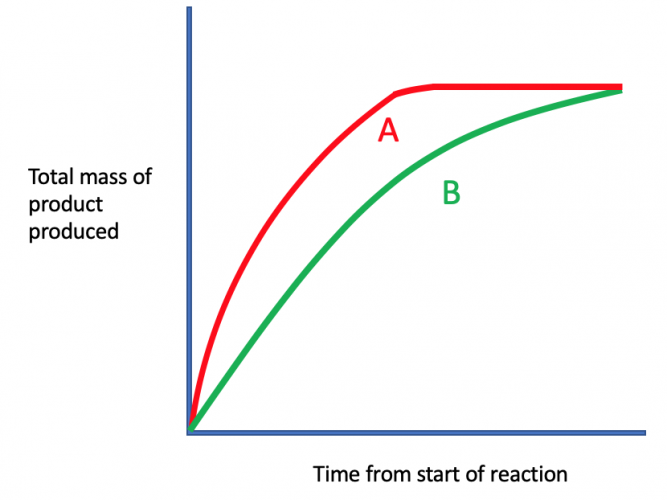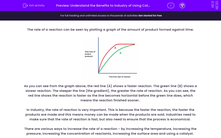The rate of a reaction can be seen by plotting a graph of the amount of product formed against time.

As you can see from the graph above, the red line (A) shows a faster reaction. The green line (B) shows a slower reaction. The steeper the line (the gradient), the greater the rate of reaction. As you can see, the red line shows the reaction is faster as the line becomes horizontal before the green line does, which means the reaction finished sooner.
In industry, the rate of reaction is very important. This is because the faster the reaction, the faster the products are made and this means money can be made when the products are sold. Industries need to make sure that the rate of reaction is fast, but also need to ensure that the process is economical.
There are various ways to increase the rate of a reaction - by increasing the temperature, increasing the pressure, increasing the concentration of reactants, increasing the surface area and using a catalyst.
Below, are some industrial reactions where the addition of a catalyst increases the rate of the reaction and makes the process more profitable.
In the Haber process, an iron catalyst is used to increase the rate of ammonia production. The presence of the catalyst also means that the reaction can be carried out at a slightly lower temperature than without, which is beneficial.
.jpg)
Sulfuric acid is made in a three step reaction. Vanadium pentoxide is the catalyst used in the second step to speed up the rate of the reaction.
Step 1: Sulfur + Oxygen → Sulfur dioxide
Step 2: Sulfur dioxide + Oxygen → Sulfur trioxide
Step 3: Water + Sulfur trioxide → Sulfuric acid
Adding a catalyst doesn't produce more sulfur trioxide - its only function is to speed up the reaction.
A nickel catalyst is used in the production of margarine. It speeds up the conversion of liquid oils to hardened fats that you can spread it on toast. By having a catalyst involved, the temperature and pressure in the process can be lowered so that it is cheaper to carry out.
Here are some advantages and disadvantages to using catalysts in industry
| Advantages | Disadvantages |
|
Catalysts speed up the rate of reaction, which saves money because the plant doesn't have to operate for as long to produce the same amount of product. |
They can be very expensive to buy. |
|
Catalysts can allow the reaction to work at a much lower temperature - lowering production costs. |
They often need to be removed from a product and cleaned before reusing. |
|
They are reusable - they never get used up in a reaction so once purchased you can use them over and over again. |
Different reactions use different catalysts, so if the industry makes more than one product you need more than one catalyst. |
| Only a small amount is needed to have a large impact on the rate of reaction. | Many catalysts are toxic and could escape into the environment and contaminate ecosystems. |
In general, using catalysts in industry leads to faster, more energy-efficient chemical reactions.
Right, let's have a go at some questions now.
Remember that you can look back at this page by clicking on the red help button on the screen at any point.








